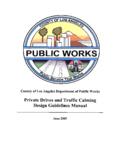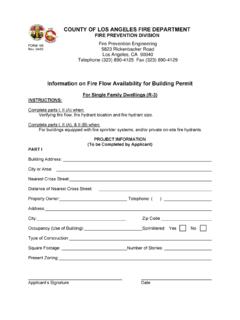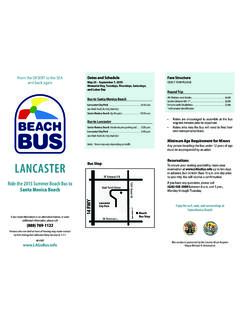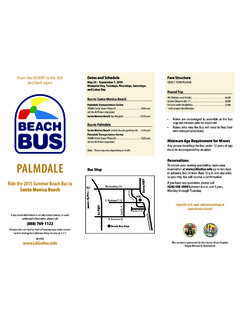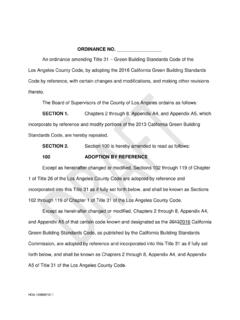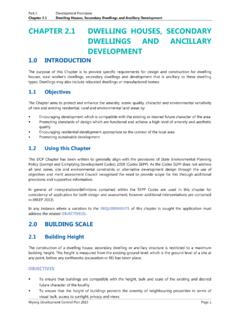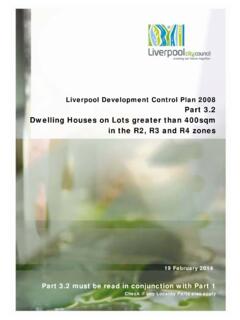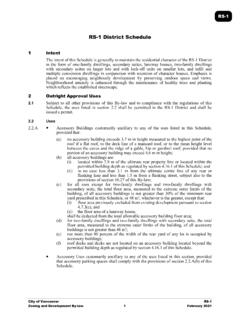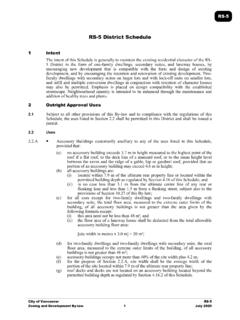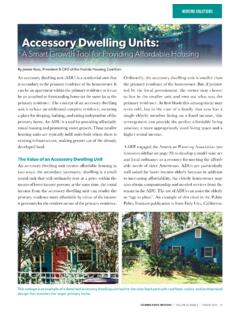Transcription of Accessory Dwelling Unit (ADU) Guidelines
1 Accessory Dwelling Unit (ADU) Guidelines Los Angeles County Building and Safety Effective January 1, 2017, new State laws went into effect to facilitate the construction of Accessory Dwelling units (ADUs) associated with single-family homes. ADUs are known by many names: granny flats, in-law units, backyard cottages, secondary units and more. Agency requirements Regional Planning Requirements (Please refer to Accessory Dwelling Unit Ordinance summary). Ministerial Site Plan review required. Fire Department Requirements An automatic residential fire sprinkler system is required unless the primary residence is not provided with an automatic sprinkler system ( ). Refer to Q11 for more info. Fuel Modification required of property is located within VHFHSZ. Referral to Fire Department is needed unless Form 195 for Fire Flow Availability meets the following: o 1,250 GPM in a fire hazard zone o 1,000 GPM for non-sprinklered and not in a fire hazard zone o 500 GPM for sprinklered and not in a fire hazard zone ADU attached to the main house cannot exceed 3,600 sq.
2 Ft. for the floor area of the entire structure unless approved by the Fire Department. Access requirements o The ADU shall be within 150 feet to all portions of the building exterior walls from a vehicular access roadway that is a minimum of 20 feet wide, paved with concrete or asphalt and does not exceed 15% grade. Environmental Health For a private septic system Public Works Drainage and Grading Section drainage review Environmental Program Division Construction and Demolition Debris Recycling Sanitation District Fee receipt School District Over 500 sq. ft. of new habitable area Local Water Company Form 195 for Fire Flow Availability and Will Serve Letter NOTE: Additional agencies may be required based on site specific conditions. ADU Guideline FAQ. Q1. For existing garage conversions to an ADU, does the existing wall within 5' of the property line need to be fire-rated? A: Yes, although the walls are existing they need to be modified to comply with the fire- rating and opening protection requirements of Table (1) or (2), whichever is applicable.
3 Q2. For existing garage conversions to an ADU, I intend to frame in the area where a garage door used to be. Do I need to install a new footing even if the wall will still be non-bearing? A: Yes, all exterior walls must be supported by continuous footings per Section The new footing shall comply with the current requirement in RCM for expansive soil. However, if the existing footing and slab show no sign of damage or cracks, the expansive soil requirements may be waived. Q3. For existing garage conversions to an ADU, do I need to comply with expansive soil conditions required in RCM A: Since converting to an ADU would not be considered less conforming than the existing garage before the conversion, expansive soil conditions would not apply per Section of the Existing Building Code. However, the concrete floor will need to be provided with a vapor retarder as required in Section Alternate materials can be proposed to prevent the passage of water vapors.
4 The following alternate products are approved for use on an existing slab that does not have a vapor retarder: 1. ICC ESR#1413 RedGard Waterproofing and Crack Prevention Membrane, C- Cure Pro-Red Waterproofing Membrane 963, CBP 232 Waterproofing and Anti- Fracture Membrane, and Jambo Waterproofing Membrane 2. ICC ESR #2417 LATICRETE Hydro Ban 3. ICC ESR #2785 Polycoat-Aquatight and Flexideck 4. ICC ESR#3474 Mapelastic AquaDefense Waterproofing Membrane Refer to Research Bulletin RB11 for any other proposed alternate product. Q4. For existing garage conversions to an ADU, do I need to upgrade or replace any structural members including foundation and slab? A: If gravity load carrying components have shown substantial structural damage, the damaged components must be replaced or rehabilitated per Section of the Existing Building Code. If there is any sign of damage or deterioration in foundation or slab, it must be repaired or upgraded to the current code standards.
5 A note requiring the owner to acknowledge possible upgrades needs to be placed on the plans. Q5. Do I need to obtain a separate address for an ADU? A: An ADU can be permitted under the existing address. However, if a separate address is desired, a request for a fractional number to the existing main address needs to be requested to Mapping and Property Management Division (MPM). For example, if the ADU Guideline main house's address is 1234 Main Street, the ADU's address will be 1234 Main Street. If an ADU has a separate driveway or street access from the main house, a separate address is required. Building and Safety staff will submit a new address request along with a site plan to MPM through iManage. However, the new address shall only be used for an ADU and shall not be released until all agencies are cleared. Q6. Do I need to install a separate utility meter or a separate service panel for an ADU?
6 A: No, however, the owner can request a separate utility meter or service panel if desired. Q7. Do I need to provide fire separation for an attached ADU? A: Yes, a 1-hour fire-resistance rating is required per Section Additionally, these common walls and floor/ceiling assemblies between units must also meet a sound transmission rating of STC 50 or higher, per section 1207 of the building code. Q8. What are the typical issues that are encountered when proposing existing garage conversions to an ADU? A: Ceiling joists may need to be upgraded due to additional loading of new ceiling drywall. Also, energy calculations will need to be submitted for creating a new conditioned space. Q9. There is no building permit on record for my existing garage. Can I still convert it to an ADU? A: If there is no record of building permit for the garage, you will need to apply for a new construction permit.
7 The proposed ADU will need to comply with the current building code as if it were new. Foundation, gravity load resisting system, and lateral load resisting system will need to be verified and upgraded if not compliant with the current code. If the existing garage was previously permitted, the ADU conversion would be an alteration permit. Q10. I would like to build a one-story addition to my existing garage to create an ADU. Do I. need to reanalyze the entire structure? A: Yes, you will need to as you are increasing the lateral load to the existing garage per Section of the Existing Building Code. However, any existing lateral load-carrying structural element taking not more than 10% additional load (demand-capacity ratio) can remain unaltered. Q11. I would like to build a detached ADU with a garage. How big can my ADU be? A: The maximum living area of an ADU is 1,200 sf. However, Los Angeles County Fire Department requires the automatic sprinkler system when the combined floor area of an ADU and an attached garage exceeds 1,200 sf.
8 Please contact Los Angeles County Fire Department if your proposed ADU is subject to the automatic sprinkler requirement. Q12. Can a single heating unit be used to heat both the single-family Dwelling and an attached ADU? ADU Guideline A: No. Section requires every Dwelling unit be provided with heating facilities. Mechanical code section and section of ASHRAE prohibits the transfer of air between adjacent Dwelling units. Therefore, a separate heating unit is required for each Dwelling unit, as a single heating system cannot separately balance air in both units without transferring the air between them. Furthermore section (a) of the energy standards includes that each Dwelling unit shall be controlled by an individual thermostatic control. Q13. Can the ADU sewer be connected to the existing house drainage/sewer system, or does it need a separate sewer connection to the main public sewer?
9 A: Per section of the plumbing code, an ADU *building sewer shall be separately connected to the public sewer, or trunk sewer (Sewer Maintenance Saddle permit or Sanitation District approval in addition to an encroachment permit are required). However, since the lot may not be subdivided in a manner that the ADU becomes a single family unit, the building sewer from the ADU may connect to the building sewer from the existing building at a point 2 feet outside of the existing building. Exception: Where ADU stands in the rear of the existing building on an interior lot and no private sewer is available or can be built to the rear ADU through an adjoining court, yard, or driveway, the *building drain from the existing building may be extended to the rear ADU. This exception is also applicable to ADU's that are physically attached to the existing building. *Building Sewer. That part of the horizontal piping of a drainage system that extends from the end of the building drain and that receives the discharge of the building drain and conveys it to a public sewer, private sewer, private sewage disposal system, or other point of disposal.
10 *Building Drain. That part of the lowest piping of a drainage system that receives the discharge from soil, waste, and other drainage pipes inside the walls of the building and conveys it to the building sewer beginning 2 feet (610 mm) outside the building wall. Accessory Dwelling Unit Electrical Requirements FAQs *All sections reference the 2014 National Electrical Code unless otherwise noted. EQ1. I want to provide power to the ADU from the existing service panel at the main Dwelling . Is it necessary to upgrade my existing service or provide the ADU with its own service connection to the utility? A: A new service to the ADU or upgrade of the existing service will not be necessary if residential load calculations are performed to confirm the installation is sufficient. If the new calculated electrical loads exceed the rating of your existing service panel then an upgrade will be required.



